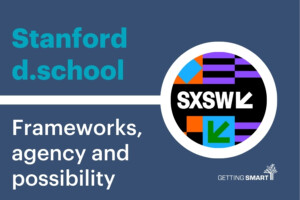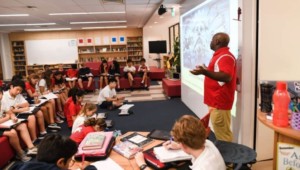Top 20 Posts from 2018

2019 is just around the corner and we can’t wait to see what the new year holds for education innovation. We’ve learned, reviewed, shared and experienced over the last 12 months. We can’t believe 2018 is already over. We’ve curated our top 20 blogs from 2018 to help inspire you to reimagine the future of learning:
1. 7 Real-World Issues That Can Allow Students To Tackle Big Challenges – Michael Niehoff
How can we creatively collaborate, critically think and communicate in ways that will make our world a better place to live? Letting our students practice thinking about and working on these seven big issues can present hundreds of relevant challenges that can be a big step toward that future.
2. Mindset, and the Power of “Yet” – Jamie Black
For Jamie Black, the “Power of Yet” poster has been a powerful strategy, a simple reminder to persevere can be the difference between a student who gives up and one who routinely concludes that understanding will come with more effort, questions or use of additional strategies.
3. Artificial Intelligence: Implications for the Future of Education – Rachelle Dene Poth
AI can increase the time available for interactive lessons, allow students to lead, free up more time to focus on relationships in the classroom and truly provide students with a world full of opportunities, personalized to their needs and instantly available.
4. The Implications of Gartner’s Top 10 Tech Trends of 2018 for Education – Jim Goodell, Liz Glowa and Brandt Redd
Education often falls behind the business world in realizing the potential of new technologies. There are, however, a few bright spots where the timing might be right for the tech trends in the business world to have a positive impact on education sooner rather than later.
This is our opportunity to reflect on 2018’s tech trends and hypothesis what trends will emerge in 2019.
5. Working with Special Needs Students: What Do All Teachers Need to Know? – Rachelle Dene Poth
All teachers need to be invested in providing for all students. We also need to make sure that the families have access to the information and resources they need in order to provide support at home as well. By setting up a means of communicating with our colleagues, the families and continuing to look for and share resources, it becomes easier to facilitate the best possible learning opportunities for all students.
6. A Blended Environment: The Future of AI and Education – Kyle Wagner
For many of us, using AI in our schools seems light years away. But by slowly and consciously embracing it, we can start to make the shifts necessary for the 21st-Century classroom.
7. 12 Digital Tools to Try in 2018 – Rachelle Dene Poth
Rachelle Dene Poth had her own list of the tools that she found made a big difference in her classroom but decided to ask her students for their input. Here are the top 12 tools she and her students thought made the biggest impact.
8. Homework or No Homework? Maybe We’re Asking the Wrong Question (Part 1) – Erin Gohl & Kristen Thorson
Academic studies on homework have shown a spectrum of results spanning conclusions that homework is the key to academic success to those saying homework is a waste of student time that damages home life. But what if homework was different?
9. Kindness Starts with One: Random Acts of Kindness Week 2018 – Mary Ryerse
Random Acts of Kindness Week 2018 featured developmentally appropriate, standards-aligned lessons that taught kids important social-emotional skills. Take a look to get inspired early for RAK Week 2019.
10. Introducing a Framework for High Quality Project Based Learning – Tom Vander Ark & Emily Liebtag
Projects are an easy way to engage students in authentic challenges, but delivering all of the possible benefits requires well-constructed, sustained and supported experiences. This new Framework can help develop such experiences.
11. 6 Emerging Technologies Supporting Personalized Learning – Meredith Allen
If we know what successful personalized learning looks like in schools and we understand the urgency of providing these opportunities to our learners, we need to start the engine.
12. 15 School Districts Worth Visiting – Getting Smart Staff
Leading a public school district is difficult and complicated work. But done well, there is no other job that can change how a community thinks about itself, its children and its future. Here, we look at 15 districts that are changing the trajectory of both education and their communities.
13. Whittle School & Studios: Transforming Education for Global Good – Getting Smart Staff
To develop the Whittle School, a world-class staff, informed by a global academic advisory board and leading-edge partners, developed a school model that incorporates 10 important innovations that set the new standard for quality education.
14. The Benefits and the Limitations of Machine Learning in Education – Will McGuinness
The classroom is a complex environment and will always contain an essentially human element that no computer can replace. Here, we look at why this is the challenge at the heart of efforts to engrain machine learning and AI in the classroom.
15. 3 Ways To Model Collaboration and Partnership in Schools and Classrooms – Michael Niehoff
Our challenge as educators is whether we walk the walk. We ask our students to collaborate, or partner, but do we truly do it ourselves? How can educators model true collaboration and partnering to our students?
16. The Entrepreneurial Mindset – Amy McGrath
More and more young people are starting to build their own businesses. Mark Greenberg is the founder and CEO of BuildEd. He uses his experience as an entrepreneur in industries ranging from consulting to real estate investment to develop entrepreneurship courses for partners like ASU Prep Digital and several K-12 programs.
17. Why The Four Cs Will Become the Foundation of Human-AI Interface – David Ross
The P21 skills framework was conceptualized with human-to-human interaction as the default assumption. David Ross reflects on the need for organizations to rethink what the 4Cs mean with the advent of AI.
18. 10 Classroom-Ready Computational Thinking Resources for K-12 – Dacia Jones
Computational thinking can help prepare the next generation for the future of work. It teaches students to process information like a computer would. It’ll guide students through a series of steps, similar to an algorithm, to solve open-ended problems.
19. Early Childhood: What We Know, and What’s Possible – Emily Liebtag and Janice Walton
We know early learning matters… and it matters a lot. We also know that all early learning experiences and are not created equal, nor are they available to all students and families. This post is the first in a series looking at how we can do better.
20. Teaching Students How to Work Together – Jamie Black
The group work structure and opportunities to practice collaboration may prove to be invaluable for students to learn how to work effectively with others so that they can succeed in the future workforce.
We are looking forward to 2019. If you have a favorite blog from 2018, let us know. Tweet at us @Getting_Smart and we can add it to the list. If you have ideas for blog content, check out our guest posting policies. If one of your new year’s resolutions is to activate your voice, we’d love to read your draft and consider it for publishing. Thanks, and Happy New Year!
Stay in-the-know with innovations in learning by signing up for the weekly Smart Update.





0 Comments
Leave a Comment
Your email address will not be published. All fields are required.